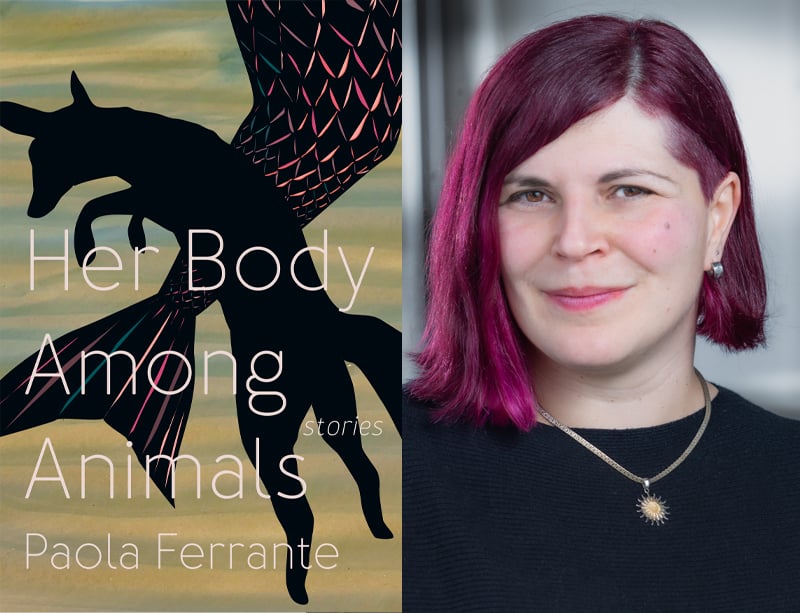As a teenager, Paola Ferrante loved Timothy Findley’s writing. She remembers hearing an anecdote about how the author once threw out a short story because he believed it was too dark and dreary, that it failed to give the reader any hope.
“That stuck with me because I do think there is hope for humanity despite the dire circumstances of our world,” she says.
Ferrante’s debut short story collection, Her Body Among Animals, published by Book*hug Press this month, certainly doesn’t shy away from darkness, but it does adhere to Findley’s dictum. Combining elements of science fiction, horror, and even fairy tales, the book is also informed by Ferrante’s work as a poet (her first poetry collection, What to Wear When Surviving a Lion Attack, was shortlisted for the Gerald Lampert Memorial Award), with lush, lyrical prose, and a keen sense of both economy and rhythm.
The collection came together over a number of years, with the first story, “When Foxes Die Electric,” finished in late 2017. (The imaginative tale of a sentient sex robot was longlisted for The Writers’ Trust of Canada McClelland & Stewart Journey Prize in 2020.) From there, the author’s own life experience – and the shifting culture around her – dictated the book’s overall direction. The #MeToo movement exploded, climate concern was buzzing with increased intensity, and Ferrante was coming to terms with her own depression. One story, “The Underside of a Wing,” inspired by her own experience of dropping out of graduate school, is told from the perspective of a student who is literally followed around by an albatross.
“I was very aware of two experiences simultaneously,” she says. “All of a sudden people were actually talking about what it was like to be living in a woman’s body and then also … wanting to talk about my own experience with living with depression.”
Another significant life event influenced the collection’s final piece – her son, a pandemic baby, was born in 2022. “So What If It’s Supposed to Rain” is a post-apocalyptic tale about a pregnant photographer trying to be the perfect mom (while, incidentally, being connected to a hive-mind-style mother dictating said perfection.) The story became a way for Ferrante to unpack urgent ideas about modern motherhood, those demands and anxieties dovetailing neatly with already present worries about the fragile state of our natural world.
“That last story was, I think, my test for myself. Can I be a mother and a writer at the same time? A lot of my mother characters are grappling with the same issues. A lot of them are artists. There’s sort of an idea that children are this self-fulfillment for women, that motherhood is a self-fulfilling role. The women in my stories have found self-fulfillment elsewhere.”
It’s clear that for Ferrante, genre writing presents a rich opportunity to explore difficult real-world truths, to come at painful things from what she refers to as a “sideways angle,” looking at them longer than we could straight-on. This attraction to the extreme goes back to an early fascination with traditional fairy tales – which she refers to as “the first horror stories” – that employ fantastic imagery to unpack common childhood fears of abandonment, violence, and death.
The visceral “Everyday Horror Show” serves up postpartum anxiety experienced as a type of poltergeist. Toxic masculinity is tackled in “The Silent Grave of Birds,” a story in which the teenage protagonist is haunted by dolls and by the guilt of witnessing a sexual assault and doing nothing. Time and again, Ferrante deftly employs the horrific to reveal uncomfortable truths about the worst of human behaviour: neglect, abuse, cruelty, and beyond.
Her Body Among Animals feels particularly urgent given the headlines that have dominated newsfeeds this year. The world is burning, and Ferrante has generously given us a way to look at that grim reality, to grapple with our feelings of terror and loss, and to process what it means to live through unrelenting catastrophe.
“I am trying to talk about deep fears in ways that will keep people wanting to read the stories.”
Yet despite this debut’s more disturbing elements, the underlying message of Her Body Among Animals is ultimately one of resilience, change, and yes, that aforementioned hope. Ferrante’s characters persevere, push against the status quo, and pursue alternatives – even if, in this dark and at times bizarre world, that means turning into a spider or refusing to go to Mars.
“I look at my kid every day and I think, ‘you have this joy on your face and I don’t want to snatch that hope from you,’” she says. “There are ways to do better if we look at the past mistakes we’ve made. If we can take that knowledge and go into the day, there is hope to change things.”

 Contact us via email
Contact us via email

